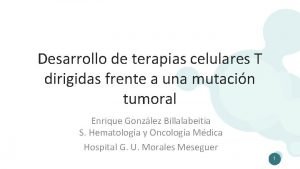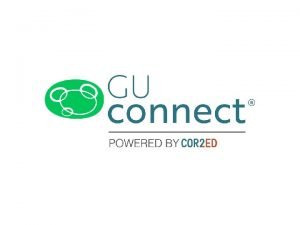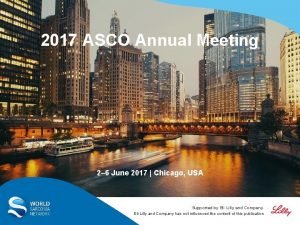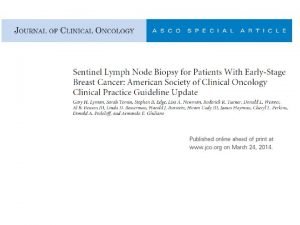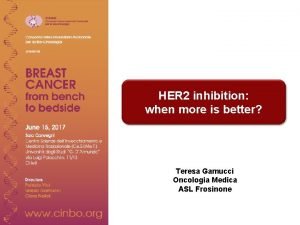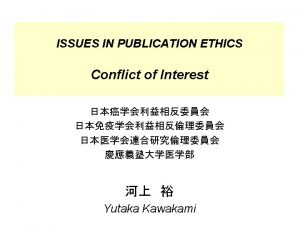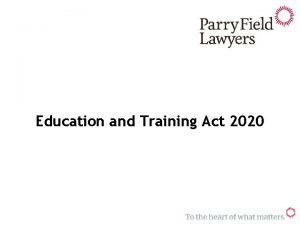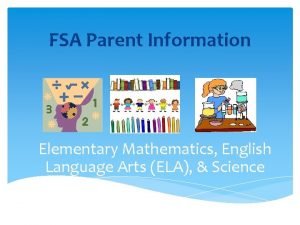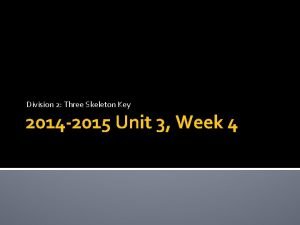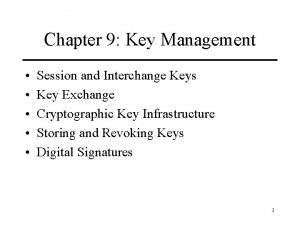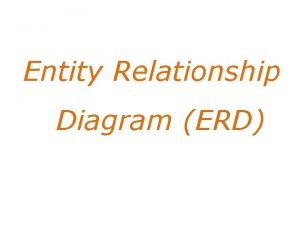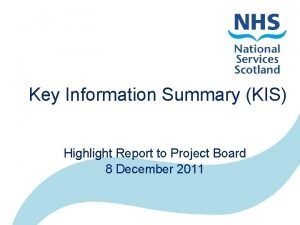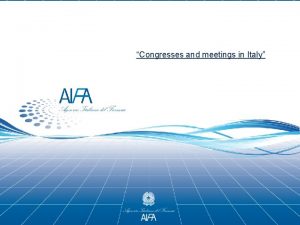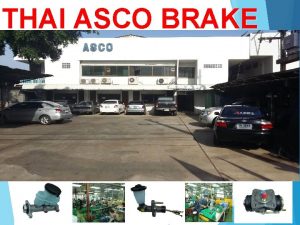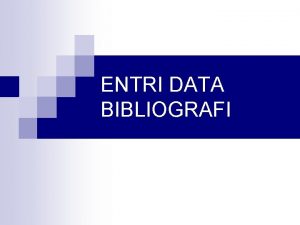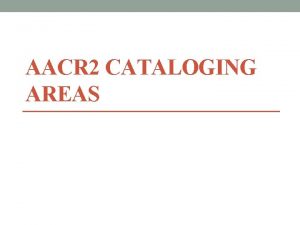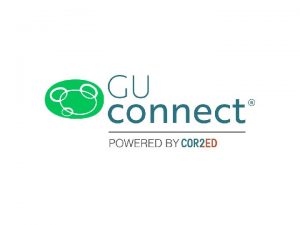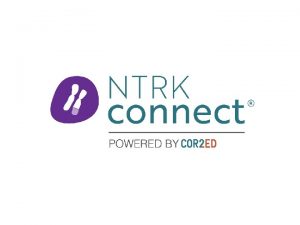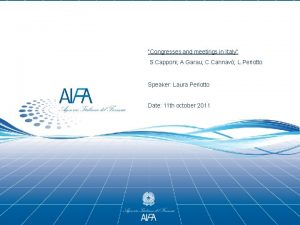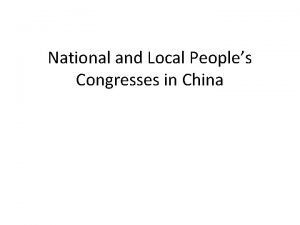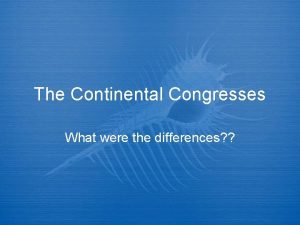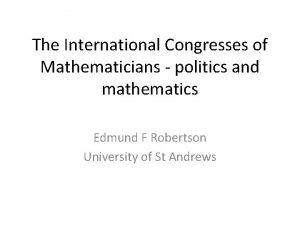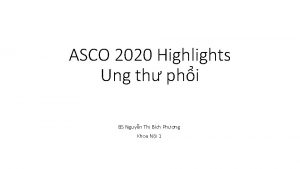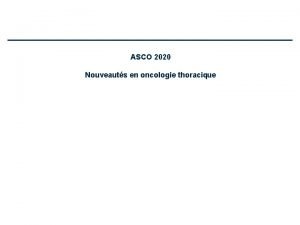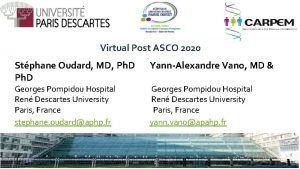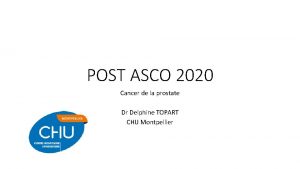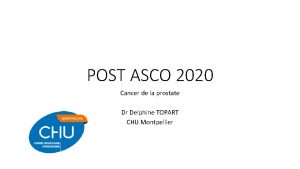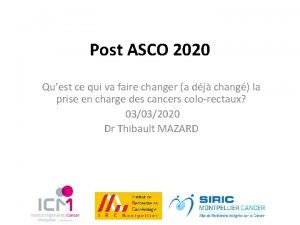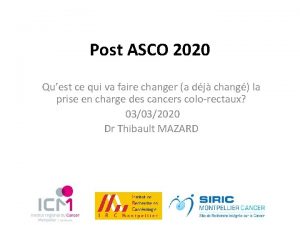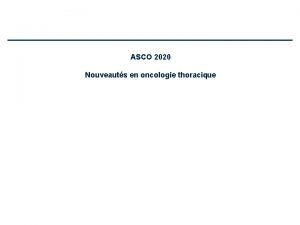SUMMARY OF KEY CONGRESSES ASCO 2020 AACR 2020
























- Slides: 24


SUMMARY OF KEY CONGRESSES ASCO 2020, AACR 2020, WCGIC 2020 VIRTUAL MEETINGS Dr Aman Chauhan University of Kentucky’s Markey Cancer Center (an NCI Designated Cancer Center), Kentucky, USA HIGHLIGHTS FROM NET CONNECT July 2020 2

DISCLAIMER AND DISCLOSURES Please note: The views expressed within this presentation are the personal opinions of the author. They do not necessarily represent the views of the author’s academic institution or the rest of the NET CONNECT group. This content is supported by an independent educational grant from Ipsen. Dr Aman Chauhan has received financial support or sponsorship for research, consultation, or speaking engagements from the following companies: • BMS, Clovis, Entrinsic Health, Ipsen, Lexicon 3

EFFICACY AND SAFETY OF SURUFATINIB IN UNITED STATES PATIENTS WITH NEUROENDOCRINE TUMOURS Dasari A, et al. ASCO 2020. Abstract #4610. Poster presentation 4

BACKGROUND • surufatinib is a targeted inhibitor of tyrosine kinases VEGFR 1, 2, and 3, FGFR 1, and CSF-1 R • Efficacy and safety of surufatinib have been confirmed in two randomised, phase 3, placebo-controlled trials in Chinese patients; both met the primary endpoint and stopped at the planned interim analysis – SANET-ep (NCT 02588170)1 • Median progression-free survival (m. PFS) 9. 2 vs 3. 8 months with placebo in patients with extrapancreatic NET (ep. NET) – SANET-p (NCT 02589821)2 • Demonstrated superior efficacy vs placebo in terms of m. PFS in patients with advanced pancreatic NET (p. NET) • Data reported here are from an ongoing dose escalation and expansion study evaluating the effects of surufatinib in US patients – Dose escalation is complete; maximum tolerated dose and recommended phase 2 dose: 300 mg once daily – Objective: to evaluate anticancer activity in select indications, including advanced or metastatic ep. NET and p. NET – Primary endpoint of expansion study: PFS – Secondary endpoints: objective response rate (ORR), disease control rate (DCR), time to response, duration of response, safety, pharmacokinetics CSF-1 R, colony-stimulating factor 1 receptor; FGFR, fibroblast growth factor receptor; NET, neuroendocrine tumour; SANET, surufatinib in advanced neuroendocrine tumours; VEGFR, vascular endothelial growth factor receptor 1. Xu J, et al. Ann Oncol. 2019; 30 suppl 5: v 911, abstract LBA 76; 2. www. chi-med. com/surufatinib-phase-iii-sanet-p-study-achieved-primary-endpoint/, accessed 25 Jun 2020 5

EFFICACY RESULTS • At data cut-off, 32 patients with heavily pre-treated progressive NETs were included: – Previous lines of therapy: median 3, range 1– 8 – All patients had received everolimus or sunitinib (or both) • 15 patients remain on active treatment – p. NET: 5 patients (31%); ep. NET: 10 patients (63%) • Tumour growth was controlled in all patients – In p. NET patients: ORR was 18% – In ep. NET patients: no confirmed partial responses (PRs) had been achieved at the time of data cut-off • surufatinib showed clinical efficacy regardless of previous therapies – p. NET: median 4 prior lines – ep. NET: median 2 prior lines p. NET (n = 16) ep. NET (n =16) 0 0 3 (18. 8) 0 13 (81. 2)a 16 (100)b 0 0 ORR, % 18. 8 0 DCR, % 100 7. 1 (2. 0– 17. 5) 4. 9 (1. 0– 10. 2) Best tumour assessment Complete response (CR), n PR, n (%) Stable disease (SD), n (%) Progression of disease (PD), n Median (range) duration of treatment, months a b One p. NET patient had an unconfirmed PR. One ep. NET patient had an unconfirmed PR. DCR, disease control rate; ep. NET, extrapancreatic neuroendocrine tumour; NET, neuroendocrine tumour; ORR, objective response rate; p. NET, pancreatic neuroendocrine tumour Dasari A, et al. ASCO 2020, abstract 4610, poster presentation 6

SAFETY RESULTS • Safety profile of surufatinib is consistent with that seen in completed trials • 30 patients (93. 8%) had at least one adverse event (AE) • 22 patients (68. 8%) had AEs of grade ≥ 3 • 5 patients discontinued treatment because of AEs – p. NET: 1; ep. NET: 4 TEAE in > 15% of patients Hypertension Fatigue Proteinuria Diarrhoea Abdominal pain AST increase Haematuria Rash Headache ALT increase Peripheral oedema Platelet count decreased Urinary retention Vomiting p. NET, n (%) (n = 16) Any grade Grade ≥ 3 6 (37. 5) 2 (12. 5) 8 (50. 0) 0 3 (18. 8) 0 8 (50. 0) 3 (18. 8) 1 (6. 3) 0 4 (25. 0) 0 3 (18. 8) 1 (6. 3) 2 (12. 5) 0 2 (12. 5) 1 (6. 3) 2 (12. 5) 0 1 (6. 3) 0 ep. NET, n (%) (n = 16) Any grade Grade ≥ 3 13 (81. 3) 7 (43. 8) 8 (50. 0) 0 13 (81. 3) 1 (6. 3) 5 (31. 3) 1 (6. 3) 7 (43. 8) 0 4 (25. 0) 0 5 (31. 3) 1 (6. 3) 6 (37. 5) 0 4 (25. 0) 0 3 (18. 8) 0 4 (25. 0) 0 1 (6. 3) 0 4 (25. 0) 0 0 3 (18. 8) 0 0 5 (31. 3) 2 (12. 5) 1 (6. 3) ALT, alanine aminotransferase; AST, aspartate aminotransferase; TEAE, treatment-emergent adverse event; ep. NET, extrapancreatic neuroendocrine tumour; p. NET, pancreatic neuroendocrine tumour Dasari A, et al. ASCO 2020, abstract 4610, poster presentation 7

SUMMARY • surufatinib has shown promising antitumour activity in US patients with progressing NETs • Its safety profile has been manageable and is comparable with the larger pool of surufatinib safety data • Previously reported pharmacokinetics and dose exposure data are also consistent with those from patients in the US and China 1 NET, neuroendocrine tumour 1. Dasari A, et al. AACR I 2020, abstract CT 115; Dasari A, et al. ASCO 2020, abstract 4610, poster presentation 8

AGITG CONTROL NET STUDY: PHASE 2 STUDY EVALUATING THE ACTIVITY OF Lu. Tate PRRT AND CAPTEM – FIRST RESULTS FOR p. NETs AND m. NETs Pavlakis N, et al. ASCO 2020. Abstract #4608. Poster presentation AGITG, Australasian Gastrointestinal Trials Group; CAPTEM, capecitabine + temozolomide; Lu. Tate, 177 lutetium-octreotate; m. NET, midgut neuroendocrine tumour; NET, neuroendocrine tumour; p. NET; pancreatic neuroendocrine tumour; PRRT, peptide receptor radionuclide therapy 9

BACKGROUND • capecitabine + temozolomide (CAPTEM) is an accepted regimen for patients with advanced p. NETs 1 • 177 lutetium-octreotate (Lu. Tate) peptide receptor radionuclide therapy (PRRT) is recommended for progressing m. NETs grade 1 or 2 after failure of medical therapy 1 • High activity of Lu. Tate–CAPTEM has been observed in a single-arm, phase 1– 2 trial 2 • The CONTROL NET study investigated whether, after progression on somatostatin analogues, Lu. Tate–CAPTEM is sufficiently active to evaluate further in a phase 3 trial 3 – Open label, non-comparative, parallel group, phase 2, cohort study COHORT 1 Grade 1 or 2 p. NET 2: 1 n = 75 COHORT 2 Grade 1 or 2 m. NET 2: 1 PRRT + CAPTEM n = 19 CAPTEM n = 9 PRRT + CAPTEM n = 33 CAPTEM n = 14 Primary endpoint • PFS (aim: 12 -month PFS 75% for p. NETs; 15 -month PFS 80% for m. NETs) Secondary endpoints • Objective tumour response rate (OTRR) • Clinical benefit rate (CBR) • Toxicity • Quality of life (Qo. L) CAPTEM: twice daily oral capecitabine 750 mg/m 2 on days 1– 14 and temozolomide 75 mg/m 2 on days 10– 14, 8 weekly x 4 PRRT: 7. 8 GBq Lu. Tate on day 10, 8 weekly x 4 m. NET, midgut neuroendocrine tumour; NET, neuroendocrine tumour; PFS, progression free survival; p. NET; pancreatic neuroendocrine tumour 1. Pavel M, et al. Neuroendocrinology. 2016; 103: 172 -85; 2. Claringbold PG, et al. Cancer Biother Radiopharm. 2012; 27: 561 -9; 3. Pavlakis N, et al. ASCO 2020, abstract 4608, poster presentation 10

RESULTS EFFICACY CAPTEM n=9 PRRT + CAPTEM n = 18 Difference in proportions (95% CI) m. NET cohort 66. 7 (28. 2– 87. 8) 75. 9 (47. 6– 90. 3) 9. 3 (− 27. 9– 46. 4) PFS proportion (range) at 15 months, % OTRR (CR or PR), n (%)a 3 (33. 3) 12 (66. 7) 33 (− 4. 4– 71) CBR (OTRR or SD), % 100 – p. NET cohort PFS proportion (range) at 12 months, % Median follow-up 34 months a ITT population. PRRT n = 13 PRRT + CAPTEM n = 32 Difference in proportions (95% CI) 92. 3 (56. 6– 98. 9) 90. 4 (73. 1– 96. 8) − 1. 9 (− 19. 7– 15. 9) OTRR (CR or PR), n (%)a 2 (15. 4) 10 (31. 3) 15. 9 (− 9. 5– 41. 5) CBR (OTRR or SD), % 92 97 – Median follow-up 35 months a ITT population. CAPTEM, capecitabine + temozolomide; CBR, clinical benefit rate; CI, confidence interval; CR, complete response; m. NET, midgut neuroendocrine tumour; OTRR, objective tumour response rate; PFS, progression free survival; p. NET; pancreatic neuroendocrine tumour; PR, partial response; PRRT, peptide receptor radionuclide therapy; SD, stable disease 11 Pavlakis N, et al. ASCO 2020, abstract 4608, poster presentation

RESULTS SAFETY • AEs were mainly haematological in the m. NETs group p. NET cohort Any AE, n (%) CAPTEM n=9 PRRT + CAPTEM n = 18 Any grade Grade 3 or 4 9 (100) 4 (44) 18 (100) 8 (44) Proportion of patients with ≥ 1 grade 3+ AE or SAE: any or related m. NET cohort Any AE, n (%) PRRT n = 13 PRRT + CAPTEM n = 32 Any grade Grade 3 or 4 13 (100) 6 (46) 32 (100) 28 (88) p. NET cohort, n (%) m. NET cohort, n (%) CAPTEM n=9 PRRT + CAPTEM n = 18 PRRT n = 13 PRRT + CAPTEM n = 32 Any grade 3+ AE 4 (44) 8 (44) 6 (46) 28 (88) Any treatment-related grade 3+ AE 3 (33) 8 (44) 6 (46) 26 (81) Any SAE 0 5 (28) 1 (8) 10 (31) Any treatment-related SAE 0 4 (22) 1 (8) 7 (22) AE, adverse event; CAPTEM, capecitabine + temozolomide; m. NET, midgut neuroendocrine tumour; p. NET; pancreatic neuroendocrine tumour; PRRT, peptide receptor radionuclide therapy; SAE, serious adverse event Pavlakis N, et al. ASCO 2020, abstract 4608, poster presentation 12

SUMMARY • This analysis showed that 15 -month PFS with CAPTEM + PRRT in the m. NET cohort and 12 -month PFS with CAPTEM + PRRT in the p. NET cohort are similarly high vs PRRT alone • PFS in both cohorts is higher than expected from initial estimates • OTRR is numerically higher with combined therapy but at the cost of greater grade 3 or 4 toxicity, mainly haematologic • The AE profile in p. NET patients is similar to that in m. NET patients • Longer follow-up is required to determine whether phase 3 evaluation is warranted AE, adverse event; CAPTEM, capecitabine + temozolomide; m. NET, midgut neuroendocrine tumour; OTRR, objective tumour response rate; PFS, progression free survival; p. NET; pancreatic neuroendocrine tumour; PRRT, peptide receptor radionuclide therapy Pavlakis N, et al. ASCO 2020, abstract 4608, poster presentation 13

DNA-PK INHIBITOR, M 3814, AS A RADIATION SENSITISER IN THE TREATMENT OF NEUROENDOCRINE TUMOURS Rychahou P, et al. AACR II 2020. Abstract #6402. Poster presentation DNA-PK, deoxyribonucleic acid-dependent protein kinase 14

BACKGROUND PRRT-CURRENT ADVANCES AND CHALLENGES • Advanced GEP-NETs remain a difficult therapeutic challenge due to their high malignant potential and resistance to conventional chemotherapy • Peptide Receptor Radionuclide Therapy (PRRT) is a potential treatment option for inoperable and metastatic GEP-NETs • The DNA-dependent protein kinase (DNA-PK) complex plays a pivotal role in non-homologous endjoining (NHEJ) repair after radiation therapy • A novel, clinical-stage DNA-PK inhibitor, M 3814 (peposertib), potently and selectively blocks the NHEJ repair pathway for DNA double strand breaks • This study investigated the feasibility of radiosensitising NET cells with M 3814, both in vitro and in preclinical NET models DNA-PK, deoxyribonucleic acid –dependent protein kinase; GEP-NET, gastroenteropancreatic neuroendocrine tumours; NET, neuroendocrine tumours; NHEJ, nonhomologous endjoining; ORR, objective response rate; OS, overall survival; PFS, progression free survival; PRRT, peptide receptor radionuclide therapy; Qo. L, quality of life Rychahou P, et al. AACR II 2020, abstract 6402, poster presentation; Strosberg, et al. N Engl J Med 2017; 376: 125 -35; Chauhan A, et al. ASCO 2020; poster presentation: abstract TPS 4660 15

RESULTS • Combination therapy with M 3814 and radiation was effective in the low-dose range (100 n. M) in selected NET cell lines Radio-sensitising effect of M 3814 in QGP-1 cells Representative photographs of clonogenic assays in (A) BON and (B) QGP-1 cells. BON and QGP-1 cells were treated with M 3814 (25, 50, 75, 100, or 125 n. M) and irradiated at doses of 1 or 2 Gy. Graphs show the mean value ± SD; each value was read in sextuplicate. NET, neuroendocrine tumour; SD, standard deviation Rychahou P, et al. AACR II 2020, abstract 6402, poster presentation 16

RESULTS EFFECTS OF M 3814 ON RADIATION-INDUCED DELAY OF TUMOUR GROWTH • Combination therapy with M 3814 and radiation effectively suppressed proliferation of QGP and BON xenografts A. Mice with QGP-1 subcutaneous tumours were randomised into four groups: vehicle, M 3814 (200 mg/kg delivered via gavage), radiation therapy (2 Gy), and a combination of radiation therapy (2 Gy) and M 3814 (200 mg/kg). M 3814 was administered 30 minutes before radiation therapy daily for 5 consecutive days. B. Mice treated with vehicle and M 3814 were euthanised 3 weeks after the start of treatment because of large tumours. Mice treated with radiation therapy alone or radiation therapy and M 3814 combined were euthanised 6 weeks after the start of treatment. DNA-PK, deoxyribonucleic acid-dependent protein kinase; XRT, radiation therapy Rychahou P, et al. AACR II 2020, abstract 6402, poster presentation DNA-PK INHIBITION AFTER M 3814 TREATMENT OF BON AND QGP CELLS • M 3814 treatment in vitro resulted in short-term DNA-PK inhibition BON and QGP-1 cells were irradiated with 4 Gy gamma rays and treated with 1, 000 n. M M 3814 30 minutes after irradiation. Protein was collected at 30 minutes, 1 hour, and 2 hours after M 3814 treatment and analysed for phospho-DNA-PK (Ser 2056) expression. 17

SUMMARY • These results demonstrate a benefit of adding MK 3814 (peposertib) to radiation therapy 1 • Selective DNA-PK inhibition by MK 3814 provides a potent therapeutic strategy for disruption of NHEJ repair of double-strand breaks and may offer a novel therapeutic approach in advanced NET 1 • The combination of MK 3814 and Lu 177 DOTATATE PRRT will be investigated further in a phase 1 trial which is under development at the Markey Cancer Center 2 PHASE 1 TREATMENT SCHEMA BOIN design Four administrations of Lu 177 DOTATATE every 8 weeks • Four peposertib (M 3814) dose cohorts • Target 25% toxicity • n = 12– 15 • (n = 14 expansion cohort after phase 1 completion) 1 2 3 4 Four cycles of peposertib (M 3814), days 1– 21 of each 28 -day cycle M 3814 (peposertib) and Lu. Tate start together on day 1 of each cycle BOIN, Bayesian optimal interval; DNA-PK, deoxyribonucleic acid-dependent protein kinase; NET, neuroendocrine tumour; NHEJ, non-homologous endjoining; PRRT, peptide receptor radionuclide therapy 1. Rychahou P, et al. AACR II 2020, abstract 6402, poster presentation; 2. Chauhan A, personal communication 2020 18

YOUNG ADULTS WITH NEUROENDOCRINE TUMOURS PRESENT HIGH RATE OF PATHOGENIC OR LIKELY PATHOGENIC GERMLINE VARIANTS IN CANCER-PREDISPOSING GENES Riechelmann R, et al. WCGIC 2020. Abstract #O-14. Oral presentation 19

BACKGROUND • Hereditary cancer predisposing syndromes are characterised by germline mutations that increase the risk of developing tumours • Recent advances in genomics, especially in next generation sequencing (NGS), have enabled the recognition of new cancer predisposing genes (CPGs) • Little is known about the role of CPGs in neuroendocrine tumours (NETs), beyond the known hereditary syndromes: – multiple endocrine neoplasia (MEN) type 1, MEN type 2, von Hippel–Lindau disease, neurofibromatosis syndrome and tuberous sclerosis complex, which are caused by the presence of germline mutations in the MEN 1, RET, VHL, NF 1 and TSC 1/TSC 2 genes, respectively • New germline mutations have been reported in 17% of pancreatic NETs , including BRCA and PALB 21 • Consecutive patients with lung or GEP NETs diagnosed under 40 years were prospectively screened without known history of cancer hereditary syndromes for germline variants in a panel of 113 CPGs of high to moderate penetrance. The results are reported here GEP, gastroenteropancreatic; MEN, multiple endocrine neoplasia; NETs, neuroendocrine tumours 1. Scarpa A, et al. Nature 2017; 543(7643): 65 -71; 2. Riechelmann R, et al. WCGIC 2020. Abstract #O-14. Oral presentation 20

RESULTS DEMOGRAPHIC DATA VARIANTS IN CANCER PREDISPOSING GENES BY PATIENT ID Age Sex Type of NET Family history Gene Variant Classification GRY_109 38 F G 2 functioning p. NET Father skin cancer, mother thyroid cancer MUTYH p. Gin 29 Ter LPV GRY_112 34 M G 1 non-functioning midgut Mother multiple myeloma POLE p. Ala 895 Profs*3 LPV GRY_118 32 F G 3 unknown primary No SDHB Deletion exon 1 PV 36 (69. 2%) GRY_122 39 F G 1 non-functioning midgut No MUTYH p. Gly 396 Asp PV 4 (25%) 5 (31. 25%) 1 (6. 25%) 0 (0%) 1 (6. 25%) 22 (42. 3%) 15 (28. 2) 4 (7. 7%) 1 (1. 9%) 3 (5. 7%) 4 (7. 7%) 3 (5. 7%) 0 GRY_133 36 M G 2 non-functioning p. NET 2 grandfathers with prostate cancer (70 and 80 yo) + grandmother with leukaemia (75 yo) XPC p. Val 548 Alafs*25 PV GRY_135 40 M G 3 non-functioning p. NET Father and brother with prostate cancer (69 and 44 yo); grandmother with colon cancer (65 yo) SLX 4 p. His 1290 Profs*45 LPV GRY_141 33 M G 2 kidney NET Maternal grandfather and paternal uncle with lung cancer (heavy smokers); paternal cousin with breast cancer XPC p. spl? LPV GRY_143 28 F G 1 appendix NET Grandfather with colorectal cancer (70 yo) MUTYH/ ERCC 3 p. spl? ; p. Arg 530 Ter PV/LPV Family history of any cancer 11 (68. 7%) 29 (55. 7%) GRY_145 33 F G 2 rectum NET Paternal grandmother with uterus cancer; paternal grandfather with gastric cancer FH p. Lys 477_Lys 477 dup LPV Family history of NET 1 (6. 25%) 3* GRY_147 40 M G 1 non-functioning midgut No ERCC 2 p. Phe 568 Tyrfs*2 LPV 1** 3*** GRY_155 39 F G 1 non-functioning midgut Father with prostate cancer ERCC 3 p. Asp 474 Glufs*2 PV Tumour grade: 1/2/3 8/4/2 27/21/4 Stage IV at diagnosis 7 (43. 7%) 25 (48%) GRY_159 37 F G 1 non-functioning p. NET Father with pancreatic cancer (58 yo); maternal aunt with MEN 1 breast cancer (60 yo); maternal grandmother with lung cancer RECQL 4 (smoker); maternal cousin with thyroid cancer (35 yo) p. Ser 555 Asn; p. Phe 850 Profs*33 LPV GRY_165 24 F G 1 gastric NET Paternal grandmother with oesophageal cancer (70 yo) MUTYH p. Gly 396 Asp PV 33 F G 1 non-functioning midgut Mother with NET; maternal grandfather with prostate cancer CHEK 2 p. Arg 117 Gly LPV Variable Pts with PV/LPV (N=14) Pts without PV/LPV (N=52) Median age (years) of NET onset 35 (24 -40) 35. 5 (14 -40) Female sex 9 (56. 3%) NET type: Pancreas Midgut Rectum Appendix Gastric Lung Unknown primary Kidney Other neoplasms *Gastric G 1, midgut and NE pulmonary hyperplasia; ** myofibroblastic tumour; *** ovarian malignant teratoma, pituitary GRY_176 adenoma; breast and papillary thyroid (both in one patient) F, female; G, grade; LPV, likely pathogenic; M, male; NE, neuroendocrine; NET, neuroendocrine tumour; p. NET, pancreatic neuroendocrine tumour; pts, patients; PV, pathogenic; yo, years old Riechelmann R, et al. WCGIC 2020. Abstract #O-14. Oral presentation 21

SUMMARY • Nearly 70% of young adults with NETs have a family history of cancer • Nearly one fifth present a pathogenic or probably pathogenic germline variant in cancer predisposing genes, with most affected genes being involved in DNA repair mechanisms – Midgut and pancreas were the most common tumour sites – Except for 1 case, all were G 1/G 2 NETs – Compared to sporadic cases, those with germline mutations were similar in terms of sex and age of onset • For future analyses, the cohort will be expanded to 200 pts and include pts whose biological samples are already collected and stored DNA, deoxyribonucleic acid; G, grade; NETs, neuroendocrine tumours; pts, patients Riechelmann R, et al. WCGIC 2020. Abstract #O-14. Oral presentation 22

REACH NET CONNECT VIA TWITTER, LINKEDIN, VIMEO, or EMAIL OR VISIT THE GROUP’S WEBSITE http: //www. net-connect. info Follow us on Twitter @net-connectinfo Follow the NET CONNECT group on Linked. In Watch us on the Vimeo Channel NET CONNECT Email antoine. lacombe @cor 2 ed. com 23

NET CONNECT Bodenackerstrasse 17 4103 Bottmingen SWITZERLAND Dr. Froukje Sosef MD +31 6 2324 3636 froukje. sosef@cor 2 ed. com Dr. Antoine Lacombe Pharm D, MBA +41 79 529 42 79 antoine. lacombe@cor 2 ed. com Heading to the heart of independent medical education since 2012
 T
T Asco gu san francisco
Asco gu san francisco 2017 asco oncology practice conference
2017 asco oncology practice conference Asco 2017 virtual meeting
Asco 2017 virtual meeting Guias asco
Guias asco Gunter von minckwitz
Gunter von minckwitz ¿cuál es tu restaurante favorito?
¿cuál es tu restaurante favorito? Coi rubber
Coi rubber Business model example
Business model example Key partners
Key partners Education and training act 2020
Education and training act 2020 Fsa test design summary 2020
Fsa test design summary 2020 Fsa test design summary 2021
Fsa test design summary 2021 Key concept summaries answer key
Key concept summaries answer key Dichotomous key for beetles
Dichotomous key for beetles Lesson 1 introduction to waves
Lesson 1 introduction to waves Three skeleton key answer key
Three skeleton key answer key Interchange key to success
Interchange key to success Perbedaan primary key dan foreign key
Perbedaan primary key dan foreign key Lesson 3 egypt's empire
Lesson 3 egypt's empire Lesson 1 summary roanoke and jamestown
Lesson 1 summary roanoke and jamestown Summary of key information
Summary of key information Przykładowa ocena pracy nauczyciela dyplomowanego 2021
Przykładowa ocena pracy nauczyciela dyplomowanego 2021 Working together to safeguard children 2018
Working together to safeguard children 2018 Mary queen of scots family tree 2020
Mary queen of scots family tree 2020
